NCERT Solutions for Class 10 Maths Chapter 3 Pair of Linear Equations in Two Variables
The third chapter is titled ‘Pair of Linear Equations in Two Variables.’ Algebra is covered in detail in Class 10 Maths Chapter 3. Students will learn to solve a linear equation with two variables in NCERT solutions Class 10 Maths chapter 3. Class 10 Maths chapter 3 NCERT solutions include answers to all NCERT exercise questions. NCERT Class 10 Maths chapter 3 solutions are useful for determining the answers to questions found in the NCERT Class 10 Maths book. Aside from that, by reading NCERT solutions for class 10 maths chapter 3, they will learn about various methods of problem solving.
NCERT Solutions for Class 10 Maths Chapter 3 Pair of Linear Equations in two variables Excercise: 3.1
Q1 Aftab tells his daughter, “Seven years ago, I was seven times as old as you were then. Also, three years from now, I shall be three times as old as you will be.” (Isn’t this interesting?) Represent this situation algebraically and graphically.
Answer: Let x be the age of Aftab and y be the age of his daughter
Now, According to the question,



Also,



Now, let’s represent both equations graphically,
From (1), we get

So, Putting different values of x we get corresponding values of y
| X | 0 | 7 | -7 |
| Y | 6 | 7 | 5 |
And From (2) we get,

So, Putting different values of x we get corresponding values of y
| X | 0 | 3 | 6 |
| Y | -2 | -1 | 0 |
GRAPH:
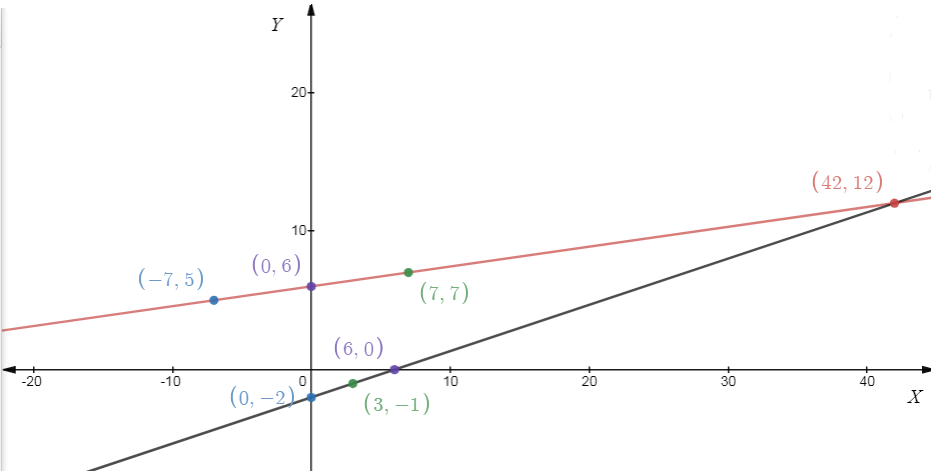
Q2 The coach of a cricket team buys 3 bats and 6 balls for Rs 3900. Later, she buys another bat and 3 more balls of the same kind for Rs 1300. Represent this situation algebraically and geometrically.
Answer:
Let the price of one Bat be x and the price of one ball be y,
Now, According to the question,


From(1) we have

By putting different values of x, we get different corresponding values of y.So
| X | 100 | 300 | -100 |
| Y | 600 | 500 | 700 |
Now, From (2), we have,

By putting different values of x, we get different corresponding values of y.So
| X | 100 | 400 | -200 |
| Y | 400 | 300 | 500 |
GRAPH:
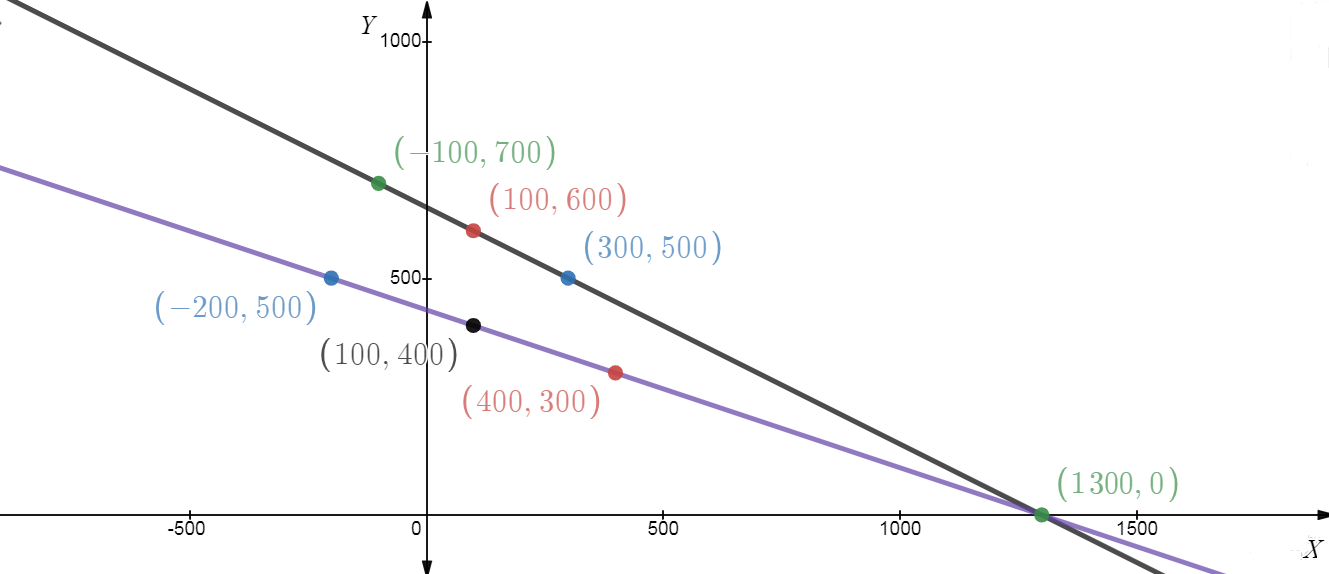


Q3 The cost of 2 kg of apples and 1kg of grapes on a day was found to be Rs 160. After a month, the cost of 4 kg of apples and 2 kg of grapes is Rs 300. Represent the situation algebraically and geometrically.
Answer:
Let, x be the cost of 1kg apple and y be the cost of 1kg grapes.
Now, According to the question,
On a day:

After One Month:

Now, From (1) we have

Putting different values of x we get corresponding values of y, so,’
| X | 80 | 60 | 50 |
| Y | 0 | 40 | 60 |
And From (2) we have,

Putting different values of x we get corresponding values of y, so,
| X | 50 | 60 | 70 |
| Y | 50 | 30 | 10 |
Graph:
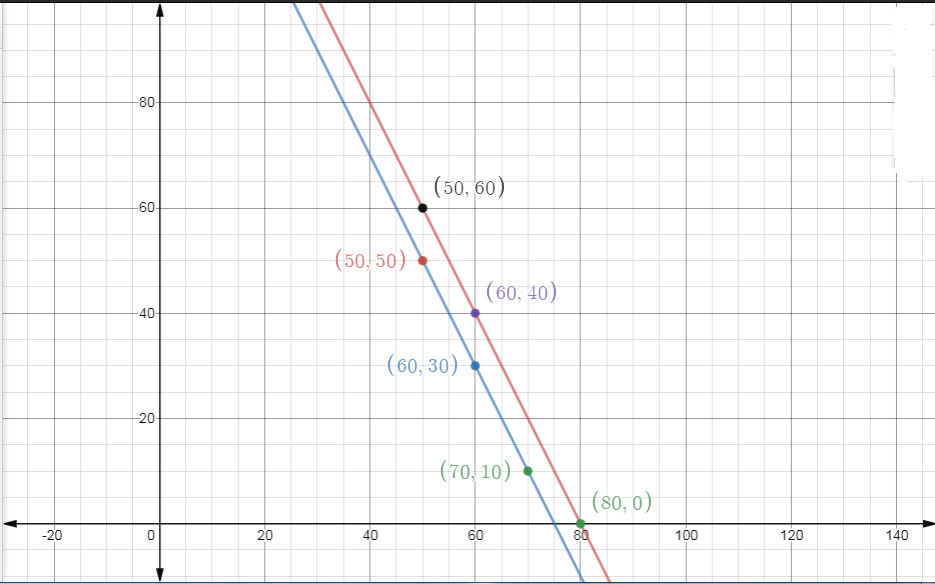


NCERT Solutions for Class 10 Maths Chapter 3 Pair of Linear Equations in Two Variables Excercise: 3.2
Q1 Form the pair of linear equations in the following problems and find their solutions graphically.
(i) 10 students of Class X took part in a Mathematics quiz. If the number of girls is 4 more than the number of boys, find the number of boys and girls who took part in the quiz.
Answer:
Let the number of boys is x and the number of girls is y.
Now, According to the question,
Total number of students in the class = 10, i.e.

And
the number of girls is 4 more than the number of boys,i.e.


Different points (x, y) for equation (1)
| X | 5 | 6 | 4 |
| Y | 5 | 4 | 6 |
Different points (x,y) satisfying (2)
| X | 5 | 6 | 7 |
| y | 1 | 2 | 3 |
Graph,
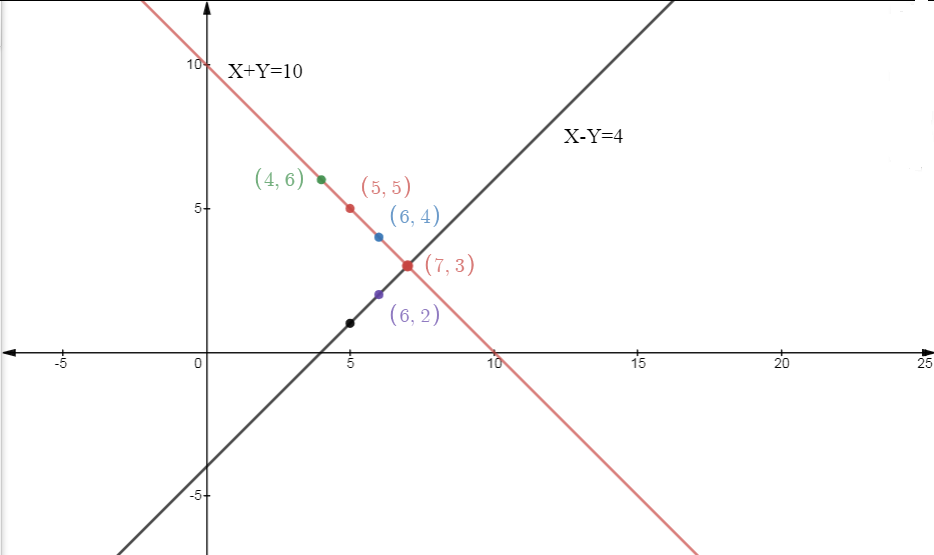


As we can see from the graph, both lines intersect at the point (7,3). that is x= 7 and y = 3 which means the number of boys in the class is 7 and the number of girls in the class is 3.
Q1 Form the pair of linear equations in the following problems and find their solutions graphically.
(ii) 5 pencils and 7 pens together cost Rs 50, whereas 7 pencils and 5 pens together cost Rs 46. Find the cost of one pencil and that of one pen.
Answer:
Let x be the price of 1 pencil and y be the price of 1 pen,
Now, According to the question

And

Now, the points (x,y), that satisfies the equation (1) are
| X | 3 | -4 | 10 |
| Y | 5 | 10 | 0 |
And, the points(x,y) that satisfies the equation (2) are
| X | 3 | 8 | -2 |
| Y | 5 | -2 | 12 |
The Graph,



As we can see from the Graph, both line intersects at point (3,5) that is, x = 3 and y = 5 which means cost of 1 pencil is 3 and the cost of 1 pen is 5.
Q2 On comparing the ratios , and , find out whether the lines representing the following pairs of linear equations intersect at a point, are parallel or coincident: (i)
Answer:
Give, Equations,

Comparing these equations with 

As we can see

It means that both lines intersect at exactly one point.
Q2 On comparing the ratios , and , find out whether the lines representing the following pairs of linear equations intersect at a point, are parallel or coincident: (ii)
Answer:
Given, Equations,

Comparing these equations with 

As we can see

It means that both lines are coincident.
Q2 On comparing the ratios , and , find out whether the lines representing the following pairs of linear equations intersect at a point, are parallel or coincident: (iii)
Answer:
Give, Equations,

Comparing these equations with 

As we can see

It means that both lines are parallel to each other.
Q2 On comparing the ratios , and , find out whether the lines representing the following pairs of linear equations are consistent, or inconsistent: (i)
Answer:
Give, Equations,

Comparing these equations with 

As we can see

It means the given equations have exactly one solution and thus pair of linear equations is consistent.
Q3 On comparing the ratios , and , find out whether the lines representing the following pairs of linear equations are consistent, or inconsistent: (ii)
Answer:
Given, Equations,

Comparing these equations with 

As we can see

It means the given equations have no solution and thus pair of linear equations is inconsistent.
Q3 On comparing the ratios , and , find out whether the lines representing the following pairs of linear equations are consistent, or inconsistent: (iii)
Answer:
Given, Equations,

Comparing these equations with 

As we can see

It means the given equations have exactly one solution and thus pair of linear equations is consistent.
Q3 On comparing the ratios , and , find out whether the lines representing the following pairs of linear equations are consistent, or inconsistent: (iv)
Answer:
Given, Equations,

Comparing these equations with 

As we can see

It means the given equations have an infinite number of solutions and thus pair of linear equations is consistent.
Q3 On comparing the ratios , and , find out whether the following pair of linear equations are consistent, or inconsistent (v)
Answer:
Given, Equations,

Comparing these equations with 

As we can see

It means the given equations have an infinite number of solutions and thus pair of linear equations is consistent.
Q4 Which of the following pairs of linear equations are consistent/inconsistent? If consistent, obtain the solution graphically: (i)
Answer:
Given, Equations,

Comparing these equations with 

As we can see

It means the given equations have an infinite number of solutions and thus pair of linear equations is consistent.
The points (x,y) which satisfies in both equations are
| X | 1 | 3 | 5 |
| Y | 4 | 2 | 0 |
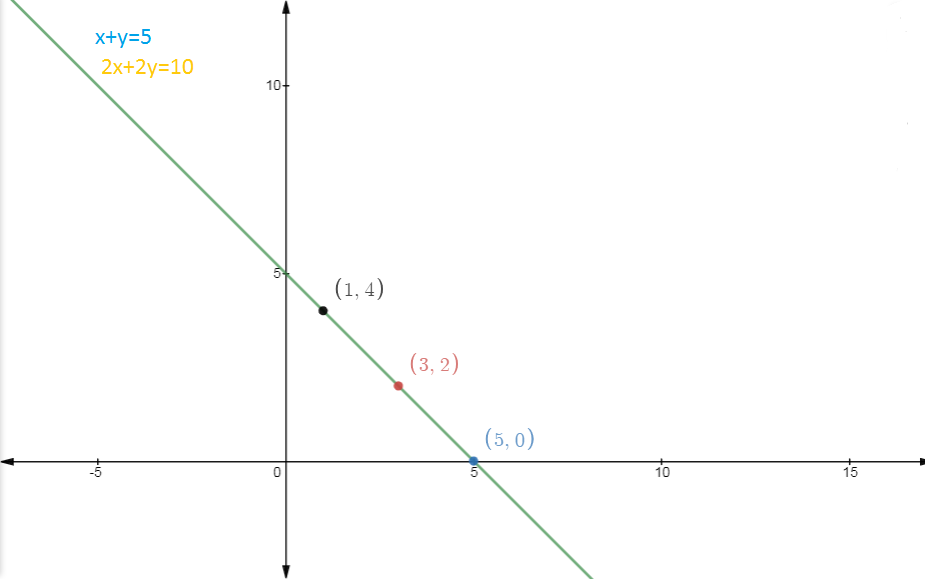


Q4 Which of the following pairs of linear equations are consistent/inconsistent? If consistent, obtain the solution graphically: (ii)
Answer:
Given, Equations,

Comparing these equations with 

As we can see

It means the given equations have no solution and thus pair of linear equations is inconsistent.
Q4 Which of the following pairs of linear equations are consistent/inconsistent? If consistent, obtain the solution graphically: (iii)
Answer:
Given, Equations,

Comparing these equations with 

As we can see

It means the given equations have exactly one solution and thus pair of linear equations is consistent.
Now The points(x, y) satisfying the equation are,
| X | 0 | 2 | 3 |
| Y | 6 | 2 | 0 |
And The points(x,y) satisfying the equation 
| X | 0 | 1 | 2 |
| Y | -2 | 0 | 2 |
GRAPH:
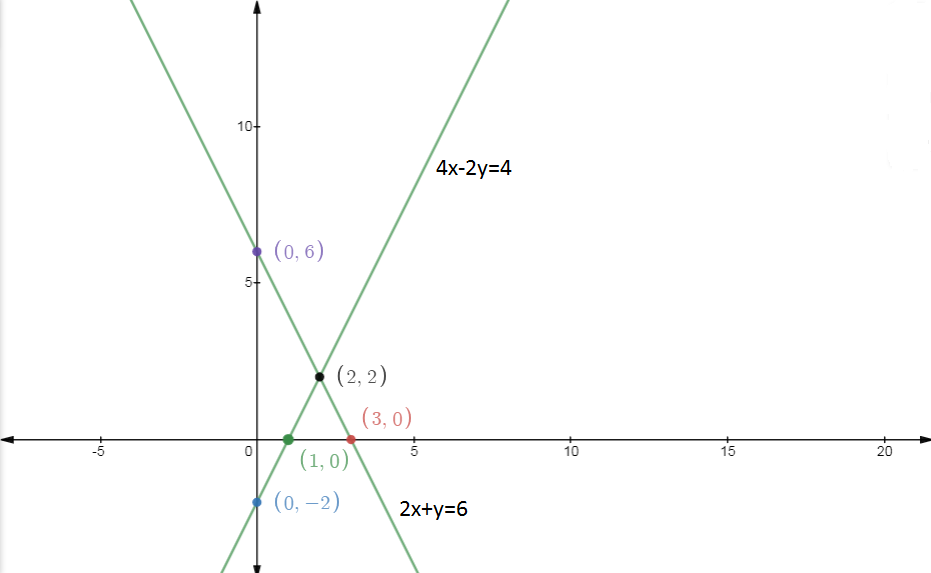


As we can see both lines intersects at point (2,2) and hence the solution of both equations is x = 2 and y = 2.
Q4 Which of the following pairs of linear equations are consistent/inconsistent? If consistent, obtain the solution graphically: (iv)
Answer:
Given, Equations,

Comparing these equations with 

As we can see

It means the given equations have no solution and thus pair of linear equations is inconsistent.
Q5 Half the perimeter of a rectangular garden, whose length is 4 m more than its width, is 36 m. Find the dimensions of the garden.
Answer:
Let 

Now, According to the question, the length is 4 m more than its width.i.e.


Also Given Half Parameter of the rectangle = 36 i.e.

Now, as we have two equations, on adding both equations, we get,



Putting this in equation (1),



Hence Length and width of the rectangle are 20m and 16 respectively.
Q6 Given the linear equation , write another linear equation in two variables such that the geometrical representation of the pair so formed is: (i) intersecting lines
Answer:
Given the equation,

As we know that the condition for the intersection of lines 

So Any line with this condition can be 
Here,


As

Q6 Given the linear equation , write another linear equation in two variables such that the geometrical representation of the pair so formed is (ii) parallel lines
Answer:
Given the equation,

As we know that the condition for the lines 

So Any line with this condition can be 
Here,



As

Q6 Given the linear equation , write another linear equation in two variables such that the geometrical representation of the pair so formed is: (iii) coincident lines
Answer:
Given the equation,

As we know that the condition for the coincidence of the lines 

So any line with this condition can be 
Here,



As

Q7 Draw the graphs of the equations and . Determine the coordinates of the vertices of the triangle formed by these lines and the x-axis, and shade the triangular region.
Answer:
Given, two equations,

And

The points (x,y) satisfying (1) are
| X | 0 | 3 | 6 |
| Y | 1 | 4 | 7 |
And The points(x,y) satisfying (2) are,
| X | 0 | 2 | 4 |
| Y | 6 | 3 | 0 |
GRAPH:
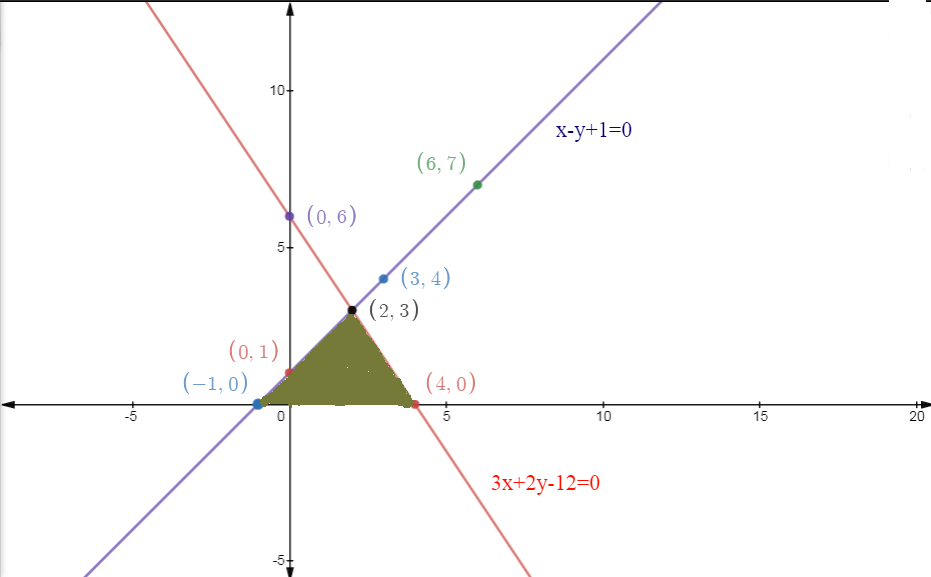


As we can see from the graph that both lines intersect at the point (2,3), And the vertices of the Triangle are ( -1,0), (2,3) and (4,0). The area of the triangle is shaded with a green color.
NCERT Solutions for Class 10 Maths Chapter 3 Pair of Linear Equations in Two Variables Excercise: 3.3
Q1 Solve the following pair of linear equations by the substitution method. (i)
Answer:
Given, two equations,

Now, from (1), we have

Substituting this in (2), we get




Substituting this value of x in (3)

Hence, Solution of the given equations is x = 9 and y = 5.
Q1 Solve the following pair of linear equations by the substitution method (ii)
Answer:
Given, two equations,

Now, from (1), we have

Substituting this in (2), we get





Substituting this value of t in (3)

Hence, Solution of the given equations is s = 9 and t = 6.
Q1 Solve the following pair of linear equations by the substitution method. (iii)
Answer:
Given, two equations,

Now, from (1), we have

Substituting this in (2), we get



This is always true, and hence this pair of the equation has infinite solutions.
As we have

One of many possible solutions is 
Q1 Solve the following pair of linear equations by the substitution method. (iv)
Answer:
Given, two equations,

Now, from (1), we have

Substituting this in (2), we get




Substituting this value of x in (3)

Hence, Solution of the given equations is,

Q1 Solve the following pair of linear equations by the substitution method. (v)
Answer:
Given, two equations,

Now, from (1), we have

Substituting this in (2), we get





Substituting this value of x in (3)

Hence, Solution of the given equations is,

Q1 Solve the following pair of linear equations by the substitution method. (vi)
Answer:
Given,

From (1) we have,

Putting this in (2) we get,









putting this value in (3) we get,





Hence 
Q2 Solve and and hence find the value of ‘ ’ for which .
Answer:
Given, two equations,


Now, from (1), we have

Substituting this in (2), we get





Substituting this value of x in (3)

Hence, Solution of the given equations is,

Now,
As it satisfies 




Hence Value of m is -1.
Q3 Form the pair of linear equations for the following problem and find their solution by substitution method.
(i) The difference between the two numbers is 26 and one number is three times the other. Find them.
Answer:
Let two numbers be x and y and let the bigger number is y.
Now, According to the question,

And

Now, the substituting value of y from (2) in (1) we get,



Substituting this in (2)

Hence the two numbers are 13 and 39.
Q3 Form the pair of linear equations for the following problem and find their solution by substitution method (ii) The larger of two supplementary angles exceeds the smaller by 18 degrees. Find them.
Answer:
Let the larger angle be x and smaller angle be y
Now, As we know the sum of supplementary angles is 180. so,

Also given in the question,

Now, From (2) we have,

Substituting this value in (1)




Now, Substituting this value of x in (3), we get

Hence the two supplementary angles are

Q3 Form the pair of linear equations for the following problems and find their solution by substitution method. (iii) The coach of a cricket team buys 7 bats and 6 balls for Rs 3800. Later, she buys 3 bats and 5 balls for Rs 1750. Find the cost of each bat and each ball.
Answer:
Let the cost of 1 bat is x and the cost of 1 ball is y.
Now, According to the question,


Now, From (1) we have

Substituting this value of y in (2)






Now, Substituting this value of x in (3)

Hence, The cost of one bat is 500 Rs and the cost of one ball 50 Rs.
Q3 Form the pair of linear equations for the following problems and find their solution by substitution method. (iv) The taxi charges in a city consist of a fixed charge together with the charge for the distance covered. For a distance of 10 km, the charge paid is Rs 105 and for a journey of 15 km, the charge paid is Rs 155. What are the fixed charges and the charge per km? How much does a person have to pay for traveling a distance of 25 km?
Answer:
Let the fixed charge is x and the per km charge is y.
Now According to the question

And

Now, From (1) we have,

Substituting this value of x in (2), we have




Now, Substituting this value in (3)

Hence, the fixed charge is 5 Rs and the per km charge is 10 Rs.
Now, Fair For 25 km :

Hence fair for 25km is 255 Rs.
Q3 Form the pair of linear equations for the following problems and find their solution by substitution method. (v) A fraction becomes , if 2 is added to both the numerator and the denominator. If, 3 is added to both the numerator and the denominator it becomes . Find the fraction.
Answer:
Let the numerator of the fraction be x and denominator of the fraction is y
Now According to the question,




Also,




Now, From (1) we have

Substituting this value of y in (2)




Substituting this value of x in (3)

Hence the required fraction is

Q3 Form the pair of linear equations for the following problems and find their solution by substitution method. (vi) Five years hence, the age of Jacob will be three times that of his son. Five years ago, Jacob’s age was seven times that of his son. What are their present ages?
Answer:
Let x be the age of Jacob and y be the age of Jacob’s son,
Now, According to the question



Also,



Now,
From (1) we have,

Substituting this value of x in (2)




Substituting this value of y in (3),

Hence, Present age of Jacob is 40 years and the present age of Jacob’s son is 10 years.
NCERT Solutions for Class 10 Maths Chapter 3 Pair of Linear Equations in Two Variables Excercise: 3.4
Q1 Solve the following pair of linear equations by the elimination method and the substitution method :
(i) 
Answer:
Elimination Method:
Given, equations

Now, multiplying (1) by 3 we, get

Now, Adding (2) and (3), we get



Substituting this value in (1) we, get



Hence,

Substitution method :
Given, equations

Now, from (1) we have,

substituting this value in (2)




Substituting this value of x in (3)

Hence,

Q1 Solve the following pair of linear equations by the elimination method and the substitution method :
(ii) 
Answer:
Elimination Method:
Given, equations

Now, multiplying (2) by 2 we, get

Now, Adding (1) and (3), we get



Putting this value in (2) we, get



Hence,

Substitution method :
Given, equations

Now, from (2) we have,

substituting this value in (1)




Substituting this value of x in (3)

Hence,

Q1 Solve the following pair of linear equations by the elimination method and the substitution method: (iii)
Answer:
Elimination Method:
Given, equations


Now, multiplying (1) by 3 we, get

Now, Subtracting (3) from (2), we get



Putting this value in (1) we, get




Hence,

Substitution method :
Given, equations


Now, from (2) we have,

substituting this value in (1)




Substituting this value of x in (3)

Hence,

Q1 Solve the following pair of linear equations by the elimination method and the substitution method :(iv)
Answer:
Elimination Method:
Given, equations

Now, multiplying (2) by 2 we, get

Now, Adding (1) and (3), we get



Putting this value in (2) we, get



Hence,

Substitution method :
Given, equations

Now, from (2) we have,

substituting this value in (1)




Substituting this value of x in (3)

Hence,

Q2 Form the pair of linear equations in the following problems, and find their solutions (if they exist) by the elimination method : (i) If we add 1 to the numerator and subtract 1 from the denominator, a fraction reduces to 1. It becomes if we only add 1 to the denominator. What is the fraction?
Answer:
Let the numerator of the fraction be x and denominator is y,
Now, According to the question,



Also,



Now, Subtracting (1) from (2) we get

Putting this value in (1)


Hence

And the fraction is

Q2 Form the pair of linear equations in the following problems, and find their solutions (if they exist) by the elimination method : (ii) Five years ago, Nuri was thrice as old as Sonu. Ten years later, Nuri will be twice as old as Sonu. How old are Nuri and Sonu?
Answer:
Let the age of Nuri be x and age of Sonu be y.
Now, According to the question



Also,



Now, Subtracting (1) from (2), we get

putting this value in (2)


Hence the age of Nuri is 50 and the age of Nuri is 20.
Q2 Form the pair of linear equations in the following problems and find their solutions (if they exist) by the elimination method : (iii) The sum of the digits of a two-digit number is 9. Also, nine times this number is twice the number obtained by reversing the order of the digits. Find the number.
Answer:
Let the unit digit of the number be x and 10’s digit be y.
Now, According to the question,

Also




Now adding (1) and (2) we get,


now putting this value in (1)


Hence the number is 18.
Q2 Form the pair of linear equations in the following problems and find their solutions (if they exist) by the elimination method : (iv) Meena went to a bank to withdraw Rs 2000. She asked the cashier to give her Rs 50 and Rs 100 notes only. Meena got 25 notes in all. Find how many notes of Rs 50 and Rs 100 she received.
Answer:
Let the number of Rs 50 notes be x and the number of Rs 100 notes be y.
Now, According to the question,

And


Now, Subtracting(1) from (2), we get

Putting this value in (1).


Hence Meena received 10 50 Rs notes and 15 100 Rs notes.
Q2 Form the pair of linear equations in the following problems and find their solutions (if they exist) by the elimination method : (v) A lending library has a fixed charge for the first three days and an additional charge for each day thereafter. Saritha paid Rs 27 for a book kept for seven days, while Susy paid Rs 21 for the book she kept for five days. Find the fixed charge and the charge for each extra day.
Answer:
Let fixed charge be x and per day charge is y.
Now, According to the question,

And

Now, Subtracting (2) from (1). we get,



Putting this in (1)


Hence the fixed charge is 15 Rs and per day charge is 3 Rs.
NCERT Solutions for Class 10 Maths Chapter 3 Pair of Linear Equations in Two Variables Excercise: 3.5
Q1 Which of the following pairs of linear equations has a unique solution, no solution, or infinitely many solutions? In case there is a unique solution, find it by using a cross multiplication method.
(i)
Answer:
Given, two equations,

Comparing these equations with 



As we can see,

Hence, the pair of equations has no solution.
Q1 Which of the following pairs of linear equations has a unique solution, no solution, or infinitely many solutions? In case there is a unique solution, find it by using a cross multiplication method.
(ii)
Answer:
Given, two equations,

Comparing these equations with 



As we can see,

Hence, the pair of equations has exactly one solution.
By Cross multiplication method,




Q1 Which of the following pairs of linear equations has a unique solution, no solution, or infinitely many solutions? In case there is a unique solution, find it by using a cross multiplication method.
(iii)
Answer:
Comparing these equations with 



As we can see,

Hence, the pair of equations has infinitely many solutions.
Q1 Which of the following pairs of linear equations has a unique solution, no solution, or infinitely many solutions? In case there is a unique solution, find it by using a cross multiplication method.
(iv)
Answer:
Given the equations,

Comparing these equations with 



As we can see,

Hence, the pair of equations has exactly one solution.
By Cross multiplication method,





Q2 (i) For which values of a and b does the following pair of linear equations have an infinite number of solutions?
Answer:
Given equations,

As we know, the condition for equations 

So, Comparing these equations with, 

From here we get,




Also,




Now, Subtracting (2) from (1) we get


Substituting this value in (1)


Hence, 
Q2 (ii) For which value of k will the following pair of linear equations have no solution?
Answer:
Given, the equations,

As we know, the condition for equations 

So, Comparing these equations with, 

From here we get,





Hence, the value of K is 2.
Q3 Solve the following pair of linear equations by the substitution and cross-multiplication methods :
Answer:
Given the equations

By Substitution Method,
From (1) we have

Substituting this in (2),




Substituting this in (3)

Hence 
By Cross Multiplication Method





Q4 Form the pair of linear equations in the following problems and find their solutions (if they exist) by any algebraic method : (i) A part of monthly hostel charges is fixed and the remaining depends on the number of days one has taken food in the mess. When a student A takes food for 20 days she has to pay Rs 1000 as hostel charges whereas a student B, who takes food for 26 days, pays Rs 1180 as hostel charges. Find the fixed charges and the cost of food per day.
Answer:
Let the fixed charge be x and the cost of food per day is y,
Now, According to the question

Also

Now subtracting (1) from (2),



Putting this value in (1)



Hence, the Fixed charge is Rs 400 and the cost of food per day is Rs 30.
Q4 Form the pair of linear equations in the following problems and find their solutions (if they exist) by any algebraic method : (ii) A fraction becomes when 1 is subtracted from the numerator and it becomes when 8 is added to its denominator. Find the fraction.
Answer:
Let numerator of a fraction be x and the denominator is y.
Now, According to the question,




Also,



Now, Subtracting (1) from (2) we get,


Putting this value in (2) we get,



Hence, the fraction is

Q4 Form the pair of linear equations in the following problems and find their solutions (if they exist) by any algebraic method : (iii) Yash scored 40 marks in a test, getting 3 marks for each right answer and losing 1 mark for each wrong answer. Had 4 marks been awarded for each correct answer and 2 marks been deducted for each incorrect answer, then Yash would have scored 50 marks. How many questions were there in the test?
Answer:
Let the number of right answer and wrong answer be x and y respectively
Now, According to the question,

And

Now, subtracting (2) from (1) we get,


Putting this value in (1)



Hence the total number of question is 
Q4 Form the pair of linear equations in the following problems and find their solutions (if they exist) by any algebraic method : (iv) Places A and B are 100 km apart on a highway. One car starts from A and another from B at the same time. If the cars travel in the same direction at different speeds, they meet in 5 hours. If they travel towards each other, they meet in 1 hour. What are the speeds of the two cars?
Answer:
Let the speed of the first car is x and the speed of the second car is y.
Let’s solve this problem by using relative motion concept,
the relative speed when they are going in the same direction= x – y
the relative speed when they are going in the opposite direction= x + y
The given relative distance between them = 100 km.
Now, As we know,
Relative distance = Relative speed * time .
So, According to the question,



Also,


Now Adding (1) and (2) we get


putting this in (1)



Hence the speeds of the cars are 40 km/hour and 60 km/hour.
Q4 Form the pair of linear equations in the following problems and find their solutions (if they exist) by any algebraic method : (v) The area of a rectangle gets reduced by 9 square units if its length is reduced by 5 units and breadth is increased by 3 units. If we increase the length by 3 units and the breadth by 2 units, the area increases by 67 square units. Find the dimensions of the rectangle.
Answer:
Let 

Now, According to the question,



Also,



By Cross multiplication method,





Hence the length and width of the rectangle are 17 units and 9 units respectively.
NCERT Solutions for Class 10 Maths Chapter 3 Pair of Linear Equations in Two Variables Excercise: 3.6
Q1 Solve the following pairs of equations by reducing them to a pair of linear equations:
(i)
Answer:
Given Equations,

Let,

Now, our equation becomes


And


By Cross Multiplication method,





And Hence,

Q1 Solve the following pairs of equations by reducing them to a pair of linear equations:
(ii)
Answer:
Given Equations,

Let,

Now, our equation becomes

And

By Cross Multiplication method,





So,


And hence

Q1 Solve the following pairs of equations by reducing them to a pair of linear equations:
(iii)
Answer:
Given Equations,

Let,

Now, our equation becomes

And

By Cross Multiplication method,





And Hence,

Q1 Solve the following pairs of equations by reducing them to a pair of linear equations:
(iv)
Answer:
Given Equations,

Let,

Now, our equation becomes

And

Multiplying (1) by 3 we get

Now, adding (2) and (3) we get


Putting this in (2)



Now,


Hence,

Q1 Solve the following pairs of equations by reducing them to a pair of linear equations: (v)

Answer:
Given Equations,

Let,

Now, our equation becomes

And

By Cross Multiplication method,





And Hence,

Q1 Solve the following pairs of equations by reducing them to a pair of linear equations:
(vi)
Answer:
Given Equations,

Let,

Now, our equation becomes

And

By Cross Multiplication method,





And Hence,

Q1 Solve the following pairs of equations by reducing them to a pair of linear equations:
(vii)
Answer:
Given Equations,

Let,

Now, our equation becomes

And

By Cross Multiplication method,





Now,


And,


Adding (3) and (4) we get,


Putting this value in (3) we get,


And Hence,

Q1 Solve the following pairs of equations by reducing them to a pair of linear equations:
(viii)
Answer:
Given Equations,

Let,

Now, our equation becomes

And

Now, Adding (1) and (2), we get



Putting this value in (1)




Now,


And


Now, Adding (3) and (4), we get



Putting this value in (3),



Hence,

Q2 Formulate the following problems as a pair of equations and hence find their solutions: (i) Ritu can row downstream 20 km in 2 hours, and upstream 4 km in 2 hours. Find her speed of rowing in still water and the speed of the current.
Answer:
Let the speed of Ritu in still water be x and speed of current be y,
Let’s solve this problem by using relative motion concept,
the relative speed when they are going in the same direction (downstream)= x +y
the relative speed when they are going in the opposite direction (upstream)= x – y
Now, As we know,
Relative distance = Relative speed * time .
So, According to the question,


And,


Now, Adding (1) and (2), we get



Putting this in (2)



Hence,

Hence Speed of Ritu in still water is 6 km/hour and speed of the current is 4 km/hour
Q2 Formulate the following problems as a pair of equations and hence find their solutions: (ii) 2 women and 5 men can together finish an embroidery work in 4 days, while 3 women and 6 men can finish it in 3 days. Find the time taken by 1 woman alone to finish the work, and also that taken by 1 man alone.
Answer:
Let the number of days taken by woman and man be x and y respectively,
The proportion of Work done by a woman in a single day

The proportion of Work done by a man in a single day

Now, According to the question,


Also,


Let,

Now, our equation becomes


And


By Cross Multiplication method,





So,

Q2 Formulate the following problems as a pair of equations and hence find their solutions: (iii) Roohi travels 300 km to her home partly by train and partly by bus. She takes 4 hours if she travels 60 km by train and the remaining by bus. If she travels 100 km by train and the remaining by bus, she takes 10 minutes longer. Find the speed of the train and the bus separately.
Answer:
Let the speed of the train and bus be u and v respectively
Now According to the question,

And


Let,

Now, our equation becomes


And



By Cross Multiplication method,





And Hence,

Hence the speed of the train and bus are 60 km/hour and 80 km/hour respectively.
NCERT Solutions for Class 10 Maths Chapter 3 Pair of Linear Equations in Two Variables Excercise: 3.7
Q1 The ages of two friends Ani and Biju differ by 3 years. Ani’s father Dharam is twice as old as Ani and Biju is twice as old as his sister Cathy. The ages of Cathy and Dharam differ by 30 years. Find the ages of Ani and Biju.
Answer:
Let the age of Ani be 

Case 1: when Ani is older than Biju
age of Ani’s father Dharam:

age of his sister Cathy :

Now According to the question,

Also,


Now subtracting (1) from (2), we get,


putting this in (1)


Hence the age of Ani and Biju is 19 years and 16 years respectively.
Case 2:

And


Now Adding (3) and (4), we get,


putting it in (3)


Hence the age of Ani and Biju is 21 years and 24 years respectively.
Q2 One says, “Give me a hundred, friend! I shall then become twice as rich as you”. The other replies, “If you give me ten, I shall be six times as rich as you”. Tell me what is the amount of their (respective) capital? [From the Bijaganita of Bhaskara II]
[Hint : ]
Answer:
Let the amount of money the first person and the second person having is x and y respectively
Noe, According to the question.


Also


Multiplying (2) by 2 we get,

Now adding (1) and (3), we get



Putting this value in (1)



Thus two friends had 40 Rs and 170 Rs respectively.
Q3 A train covered a certain distance at a uniform speed. If the train would have been 10 km/h faster, it would have taken 2 hours less than the scheduled time. And, if the train were slower by 10 km/h; it would have taken 3 hours more than the scheduled time. Find the distance covered by the train.
Answer:
Let the speed of the train be v km/h and the time taken by train to travel the given distance be t hours and the distance to travel be d km.
Now As we Know,



Now, According to the question,


Now, Using equation (1), we have

Also,




Adding equations (2) and (3), we obtain:
Substituting the value of x in equation (2), we obtain:



Putting this value in (1) we get,

Hence the distance covered by train is 600km.
Q4 The students of a class are made to stand in rows. If 3 students are extra in a row, there would be 1 row less. If 3 students are less in a row, there would be 2 rows more. Find the number of students in the class.
Answer:
Let the number of rows is x and the number of students in a row is y.
Total number of students in the class = Number of rows * Number of students in a row
Now, According to the question,

Also,

Subtracting equation (2) from (1), we get:
Substituting the value of y in equation (1), we obtain:
Hence,
The number of rows is 4 and the Number of students in a row is 9.
Total number of students in a class
: 
Hence there are 36 students in the class.
Q5 In a , . Find the three angles.
Answer:
Given,












Also, As we know that the sum of angles of a triangle is 180, so



Now From (1) we have

Putting this value in (2) we have



Putting this in (3)

And

Hence three angles of triangles 
Q6 Draw the graphs of the equations and . Determine the coordinates of the vertices of the triangle formed by these lines and the y-axis.
Answer:
Given two equations,

And

Points(x,y) which satisfies equation (1) are:
| X | 0 | 1 | 5 |
| Y | -5 | 0 | 20 |
Points(x,y) which satisfies equation (1) are:
| X | 0 | 1 | 2 |
| Y | -3 | 0 | 3 |
GRAPH:
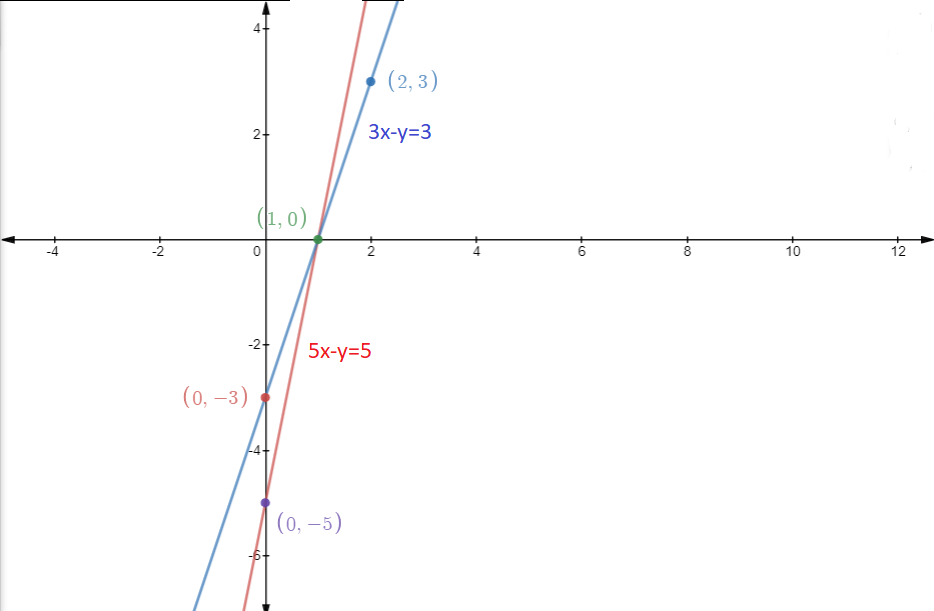


As we can see from the graph, the three points of the triangle are, (0,-3),(0,-5) and (1,0).
Q7 Solve the following pair of linear equations: (i)
Answer:
Given Equations,

Now By Cross multiplication method,




Q7 Solve the following pair of linear equations: (ii)
Answer:
Given two equations,

Now By Cross multiplication method,




Q7 Solve the following pair of linear equations: (iii)
Answer:
Given equation,

Now By Cross multiplication method,




Q7 Solve the following pair of linear equations: (iv)
Answer:
Given,

And

Now, Subtracting (1) from (2), we get




Substituting this in (1), we get,




Hence,

Q7 Solve the following pair of linear equations: (v)
Answer:
Given Equations,

As we can see by adding and subtracting both equations we can make our equations simple to solve.
So,
Adding (1) and )2) we get,


Subtracting (2) from (1) we get,


Now, Adding (3) and (4) we get,


Putting this value in (3)


Hence,

Q8 ABCD is a cyclic quadrilateral (see Fig. 3.7). Find the angles of the cyclic quadrilateral.
Answer:
As we know that in a quadrilateral the sum of opposite angles is 180 degrees.
So, From Here,



Also,


Multiplying (1) by 3 we get,

Now,
Subtracting, (2) from (3) we get,


Substituting this value in (1) we get,



Hence four angles of a quadrilateral are :



